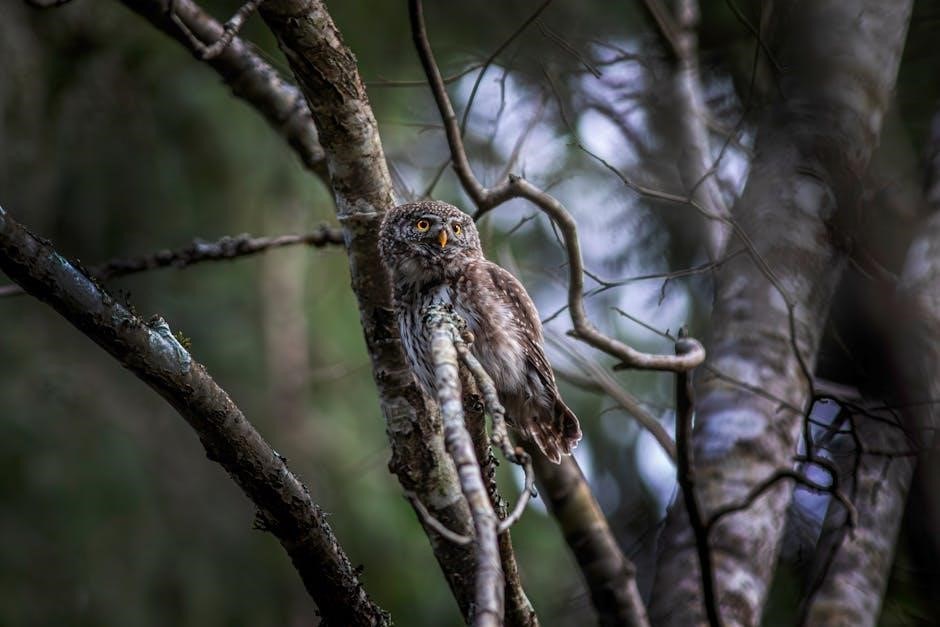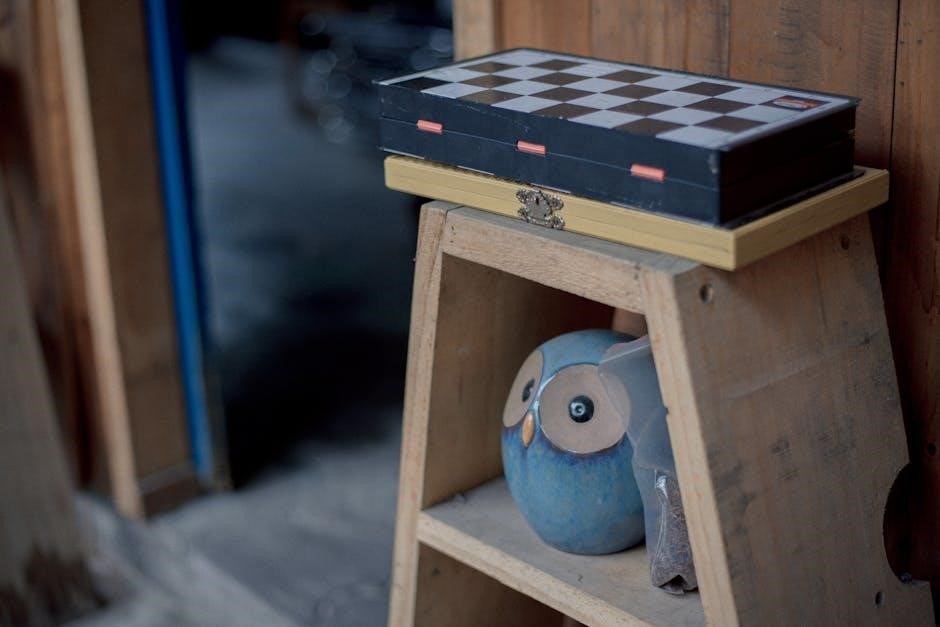Screech owl box plans provide essential nesting sites for these small, cavity-dwelling birds, helping conserve populations by offering safe habitats for breeding and roosting in urban and woodland areas.
1.1 Importance of Nesting Boxes for Screech Owls
Screech owls are cavity-nesting birds that rely on tree holes or rock crevices for shelter and breeding. However, habitat loss and declining tree cavities have reduced their natural nesting sites. Nesting boxes provide artificial alternatives, ensuring these owls have safe spaces for laying eggs and raising chicks; By installing nesting boxes, individuals can support local screech owl populations, helping to conserve these birds in urban and woodland areas. The boxes also protect owls from predators and harsh weather, making them a vital tool for wildlife conservation and ecosystem balance. Additionally, nesting boxes aid in roosting during winter, further enhancing their importance for screech owl survival.
1.2 Brief Overview of Screech Owl Box Design
Screech owl boxes are specifically designed to mimic natural tree cavities, providing a safe habitat for nesting and roosting. The typical design features a rectangular or square structure with a sloped roof to ensure water runoff and a small entrance hole (usually 3 inches in diameter) to protect against predators. The box is constructed from durable, untreated wood like cedar, cypress, or redwood, which naturally resist rot and insects. Internal dimensions are compact, with a floor size of approximately 6×6 inches and a depth of 12-15 inches, ensuring the owls have enough space to move comfortably while maintaining heat efficiency.
The design often includes a removable front panel or hinged roof for easy cleaning and maintenance. Drainage holes at the base and ventilation slots near the top are essential for air circulation and moisture control. Mounting hardware, such as screws or nails, is used to secure the box to trees or poles, typically 10-30 feet above ground. This design ensures the box blends into the environment while providing a cozy, protected space for screech owls to thrive.
Materials and Tools Required
Untreated wood (cedar, cypress, or redwood) is ideal for durability. Essential tools include a miter saw, drill, and screws. Additional materials like hinges and wood glue are also needed.
2.1 Recommended Wood Types (Cedar, Cypress, Redwood)
Cedar, cypress, and redwood are highly recommended for screech owl boxes due to their natural resistance to rot and insects. Cedar is aromatic and repels pests, while cypress and redwood are durable and moisture-resistant. These woods are ideal for outdoor use without treatment, ensuring safety for the owls. Untreated wood is essential to avoid harming the birds. Other options like pine or plywood can be used but may require sealing. Avoid treated wood, as it can release harmful chemicals. These wood types are optimal for constructing long-lasting, safe nesting boxes for screech owls.
2.2 Essential Tools (Miter Saw, Drill, Screws)
A miter saw is crucial for making precise cuts in wood, ensuring clean edges for the box’s components. A drill is necessary for creating pilot holes and driving screws, while outdoor-grade screws (1-1/4 or 1-5/8 inches) are recommended for durability. Hinges are optional but useful for easy access during cleaning. Pre-drilling holes prevents wood splitting, and waterproof glue can enhance the box’s integrity. Sanding tools may be used to smooth surfaces, and clamps help hold pieces together during assembly. Stainless steel or weather-resistant fasteners are ideal for outdoor conditions, ensuring the box withstands the elements and remains secure for the owls.

Detailed Screech Owl Box Plans
Detailed plans include specific dimensions for floors, sides, and roofs, ensuring proper assembly. The entrance hole, typically 3 inches in diameter, is strategically positioned for easy access.
3.1 Floor, Side, and Roof Dimensions
The floor of the screech owl box typically measures 14 inches in length and 12 inches in width, while the sides are 16 inches tall. The roof is slightly longer, around 22 inches, to ensure proper coverage and drainage. These dimensions are carefully designed to accommodate the owl’s nesting needs while keeping the structure compact. The entrance hole, placed approximately 16 inches above the floor, is a critical feature. The roof is often slanted to prevent water accumulation. Detailed plans specify precise cuts and measurements to ensure the box is both functional and durable, using materials like untreated cedar or redwood for longevity.
3.2 Entrance Hole Size and Placement
The entrance hole for a screech owl box should be 3 inches in diameter, drilled 16 inches above the floor to ensure proper access and prevent water intrusion. The hole should be centered on the front panel, facing an open area to provide a clear flight path. This size and placement are critical for attracting screech owls while deterring larger predators. A jigsaw or hole saw is recommended for cutting the entrance hole, and the edges should be sanded smooth to avoid injuring the owls. Proper alignment and positioning ensure the box is functional and appealing to the target species.
3.3 Assembly Instructions
Assemble the screech owl box by first attaching the sides and back to the floor using 1-1/4″ outdoor screws. Drill pilot holes to prevent splitting. Secure the front panel, ensuring the entrance hole is properly aligned. Attach the roof with hinges for easy access and add a small latch. Use waterproof glue on seams and drill 3/8″ vent holes in the sides for airflow. Avoid using nails, as they can split the wood. Sand all edges smooth to protect the owls. Allow the box to dry completely before installation. Follow these steps to ensure a sturdy, weather-tight habitat for screech owls.

Placement and Installation
Mount the box 10-30 feet high on trees or metal poles, facing east for warmth. Ensure a clear flight path to the entrance hole.
4.1 Ideal Height and Location for Boxes
Screech owl boxes should be installed 10-30 feet above ground, ideally below the tree canopy for easy access. Mount them on trees or metal poles in woodland edges, open woods, or yards with large trees. Face the entrance hole east to provide warmth during colder months. Ensure a clear flight path to the box, avoiding obstructions like branches. In urban areas, place boxes at least 20 feet away from buildings but within view for monitoring. For areas with squirrel activity, consider metal poles to deter predators. Install multiple boxes 100 feet apart to attract more owls and reduce competition.
4.2 Mounting on Trees or Metal Poles
Mounting screech owl boxes on trees or metal poles ensures stability and predator deterrence. For trees, attach the box under a limb or in a shaded area using screws or nails. Metal poles are ideal in open spaces; bury the pole 2 feet deep for stability. Use a predator guard to prevent raccoons and snakes from climbing. Face the box east to shield from harsh winds. Ensure the box is level and secure to avoid movement. In urban settings, mounting on fences or chimneys can also be effective, provided the location is safe and accessible for the owls.
Maintenance and Monitoring
Regularly clean and monitor screech owl boxes to ensure they remain safe and habitable. Check for predators, debris, and occupancy, and perform annual inspections to maintain functionality.
5.1 Cleaning and Upkeep of the Box
Regular cleaning and upkeep of screech owl boxes are crucial for maintaining a safe and healthy environment for the owls. Remove debris, feathers, and nesting material annually, ideally after the breeding season. Inspect for damage, rot, or predator signs, and repair as needed. Use untreated wood to avoid harming the owls, and ensure the box remains dry by checking for water damage. Clean the entrance hole and interior with a soft brush or cloth to remove dirt and parasites. Avoid using chemicals, as they can deter owls from using the box. Perform maintenance in late winter or early spring to prepare for the upcoming nesting season.
5.2 Tips for Observing Screech Owl Activity
Observing screech owl activity requires patience and the right approach. Position yourself quietly near the nesting box at dusk or dawn when owls are most active. Use binoculars to avoid disturbing them. Look for signs like frequent flights to the box or feeding behavior. Install a camera trap or motion-sensitive light for remote monitoring. Keep a journal to track nesting timelines, number of chicks, and feeding patterns. Avoid frequent checks during nesting season to prevent stressing the owls. Place boxes in visible locations to monitor activity easily. Enjoy this unique opportunity to study these birds while ensuring their safety and well-being.

Additional Considerations
When installing screech owl boxes, consider predator protection, camouflage, and using untreated, durable wood like cedar or redwood for longevity and owl safety.
6.1 Predator Protection Measures
Predator protection is crucial when installing screech owl boxes to ensure the safety of the owls and their young. Common predators include snakes, raccoons, and larger owl species. To deter these threats, consider using a metal collar or predator guard around the mounting pole or tree trunk. This prevents climbers from reaching the box. Additionally, mounting the box 10–15 feet above ground can reduce predator access. Ensure the box is made from durable, untreated wood like cedar or redwood, as these materials resist chewing and weathering. Avoid using plastic boxes, as predators can easily breach them. Smooth surfaces around the entrance hole can also discourage climbing insects and small predators. Regularly inspect the box for damage or signs of predation to ensure the owls’ safety.
6.2 Camouflage and Wood Chip Bedding
Camouflaging the screech owl box helps it blend seamlessly into its surroundings, reducing human disturbance and predator attraction. Use natural materials like bark or leaves to cover the exterior, ensuring it matches the local environment. Avoid painting the box, as bright colors can deter owls and attract unwanted attention.
Add a layer of wood chips or sawdust inside the box for bedding. This provides insulation and helps maintain cleanliness. Use untreated wood chips to prevent chemical exposure. Ensure the bedding is dry to avoid moisture buildup, which can harm the owls. Proper camouflage and bedding enhance the box’s appeal to screech owls, making it a welcoming habitat for nesting and roosting.

Biology and Habitat of Screech Owls
Screech owls are small, cavity-dwelling birds with gray or brown color phases, residing year-round in urban and woodland habitats, adapting well to human-modified environments for nesting and roosting.
7.1 Nesting Habits and Breeding Season
Screech owls typically breed from mid-March to early summer, with pairs forming during the winter. They prefer nesting in tree cavities or man-made boxes, often reusing sites annually. Females lay 4–6 eggs, incubating them for about 26 days. Both parents contribute to feeding the young, which fledge after 4–5 weeks. Nest boxes are crucial as natural cavities are scarce. Installing boxes in ideal locations, such as woodland edges or near large trees, can attract breeding pairs. Conserving these habitats ensures successful nesting and supports local populations.
7.2 Diet and Behavior Relevant to Nesting Boxes
Screech owls are primarily insectivorous, feeding on insects, small mammals, and occasionally birds. Their nocturnal behavior means they hunt at night, using acute hearing and vision. Nesting boxes attract breeding pairs, as these owls prefer cavity-dwelling habitats. They are monogamous, with pairs often staying together for life. Nest boxes provide crucial shelter for incubation and raising young, especially in urban areas where natural cavities are scarce. The owls’ year-round use of boxes for roosting highlights their dependence on these structures. Understanding their diet and behavior aids in designing effective nesting boxes that support their ecological needs and promote successful breeding cycles.
Proper installation and maintenance of screech owl boxes are crucial for successful nesting and species conservation, ensuring these birds continue to thrive in various habitats with human support always;
8.1 Final Tips for Successful Screech Owl Box Installation
To ensure success, install boxes in shaded areas with clear flight paths, facing east to avoid direct sun. Mount boxes 10-30 feet high on sturdy trees or poles, avoiding predator-prone locations. Use untreated wood and refrain from painting interiors to maintain natural safety. Add a 2-3 inch layer of wood chips inside for nesting comfort. Install multiple boxes if possible, spaced at least 100 feet apart, to attract more owls. Regularly inspect and clean boxes to prevent parasite buildup. Avoid placing boxes near active nests of competitive species like starlings. Follow local guidelines and seek expert advice for optimal results in your region.



